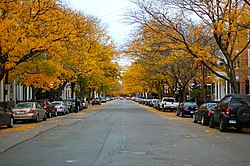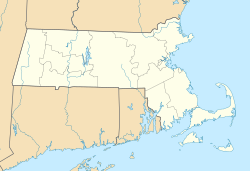Chestnut Street District
|
Chestnut Street District
|
|

Looking east on Chestnut Street in the fall
|
|
| Location | Salem, Massachusetts |
|---|---|
| Coordinates | 42°31′13″N 70°54′8″W / 42.52028°N 70.90222°WCoordinates: 42°31′13″N 70°54′8″W / 42.52028°N 70.90222°W |
| Built | 1651 |
| Architect | Multiple |
| Architectural style | Mid 19th Century Revival, Colonial, Federal |
| NRHP Reference # | |
| Added to NRHP | August 28, 1973 |
The Chestnut Street District is a historic district bounded roughly by Broad, Flint, Federal, and Summer Streets in Salem, Massachusetts. It is also known as the McIntyre Historic District that was added to the National Register of Historic Places in 1981 and containing 407 buildings and is the city's largest district. This historic district is named after Samuel McIntire, a builder and woodworker who had a house and workshop at 31 Summer Street, and who designed and built a number of these houses, and others that display the profits made in the Old China Trade by Salem's merchants.
The first of the great brick Federal houses to be constructed was the Thomas Saunders House at number 39 Chestnut, built in 1805 and later remodeled by Arthur Little (1893). Saunders also built the famous McIntire-designed double house next door at numbers 41-43, in 1810, as a wedding present for his daughters Mary Elizabeth and Caroline, who married brothers Leverett and Nathaniel Saltonstall. Leverett Saltonstall I was Salem's first elected mayor.
Hamilton Hall is a National Historic Landmark at 9 Chestnut Street in Salem, Massachusetts. [3] Hamilton Hall was built in 1805 by Samuel McIntire and added separately to the National Register of Historic Places in 1970.
The Ropes Mansion (late 1720s), also called Ropes Memorial, is a Georgian Colonial mansion located at 318 Essex Street. It is now operated by the Peabody Essex Museum and open to the public.
...
Wikipedia


